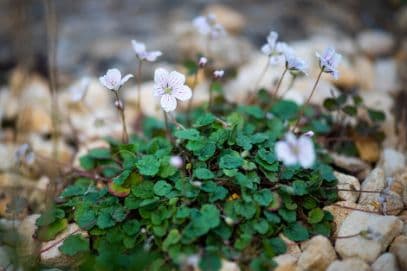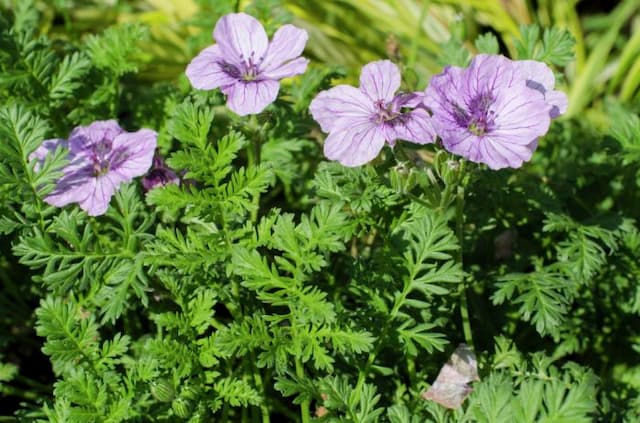Kashmir White Crane's-bill Geranium clarkei 'Kashmir White'

ABOUT
Geranium 'Kashmir White', also known as cranesbill, is a charming and eye-catching perennial plant. It boasts delicate, softly lobed, palmate leaves that often have a hue of greenish-grey, creating a serene backdrop for its floral display. The foliage may also acquire reddish tones in the autumn, adding to its visual interest throughout the growing season. This plant is particularly admired for its abundant flowering habit; it produces an impressive amount of blossoms that cover the plant in a frothy wave of color. The flowers of 'Kashmir White' cranesbill are characterized by their exquisite beauty. Each flower has five rounded petals that come in a pristine white color, which may sometimes exhibit small veins of pale lilac or pink that add a subtle hint of pattern. At the heart of each bloom, there is a cluster of prominent stamens that are often a contrasting shade of pink or purple, creating a striking focal point that draws the eye. In terms of its growth habit, cranesbill forms a clump that fills out with lush foliage and flowering stems, interweaving gracefully with neighboring plants in a garden bed. It is well-suited for borders and works well in cottage garden settings, rock gardens, or other informal landscape designs. Cranesbill is also a magnet for pollinators such as bees and butterflies, who are attracted to the nectar-rich flowers, enhancing its role as a valuable component of any eco-friendly garden space.
About this plant
 Names
NamesFamily
Geraniaceae
Synonyms
Kashmir White Geranium, Clarke's Geranium
Common names
Geranium clarkei 'Kashmir White'
 Toxicity
ToxicityTo humans
The Geranium, specifically Geranium clarkei 'Kashmir White', is not known to be toxic to humans. Ingesting any part of this plant is unlikely to cause serious harm or poisoning. However, like with any plant material, individual sensitivity such as mild stomach upset and skin irritation can occur, particularly among those with plant allergies or sensitivities.
To pets
Geraniums, including Geranium clarkei 'Kashmir White', are generally considered to be non-toxic to pets. Ingesting parts of this plant is unlikely to result in serious poisoning for pets such as dogs and cats. However, as with humans, some pets might experience mild gastrointestinal upset if they consume the plant due to individual sensitivities.
 Characteristics
CharacteristicsLife cycle
Perennials
Foliage type
Deciduous
Color of leaves
Green
Flower color
White
Height
1-2 feet (30-60 cm)
Spread
1-2 feet (30-60 cm)
Plant type
Herb
Hardiness zones
5
Native area
Himalayas
Benefits
 General Benefits
General Benefits- Attracts Pollinators: Geranium 'Kashmir White' attracts bees and butterflies, which help pollinate other plants in the garden.
- Low Maintenance: It requires minimal care once established, making it a good choice for gardeners of all skill levels.
- Drought Tolerance: Once established, it has good drought tolerance, reducing the need for frequent watering.
- Ground Cover: The plant spreads to form dense clumps, offering effective ground cover and suppressing weeds.
- Ornamental Appeal: With its white flowers and deeply lobed leaves, it adds visual interest and aesthetic value to gardens.
- Seasonal Interest: This geranium species blooms from late spring to early summer, providing seasonal color and interest.
- Hardy Perennial: It is a hardy perennial that can survive in a range of climates and come back year after year.
- Erosion Control: Its root system can help stabilize soil and prevent erosion on slopes or in other erosion-prone areas.
- Wildlife Habitat: Provides shelter and breeding spots for small wildlife and beneficial insects.
- Compatibility: It can be easily combined with other plants in a border or bed for complementary displays.
 Medical Properties
Medical PropertiesThis plant is not used for medical purposes.
 Air-purifying Qualities
Air-purifying QualitiesThis plant is not specifically known for air purifying qualities.
 Other Uses
Other Uses- Photographic subject: The Kashmir White geranium, with its distinctive blossoms, can serve as a beautiful subject for botanical photography or as inspiration for botanical illustrations.
- Educational tool: Botany students and educators can use the Kashmir White geranium to study plant structure, pollination, and the lifecycle of flowering plants.
- Companion planting: Gardeners may plant Kashmir White geraniums near vegetables and fruits as they can attract beneficial insects that help in pollination or pest control.
- Natural dye: The petals of the Kashmir White geranium could be used to produce a light, natural dye for fabrics or paper crafts.
- Garden design: Because of its subtle color and foliage, Kashmir White can be used in monochromatic garden designs or moon gardens, where white-flowering plants are highlighted.
- Floral arrangements: Fresh or dried, Kashmir White geranium flowers can be used in floral arrangements, adding a delicate touch to bouquets or indoor displays.
- Culinary decoration: Edible varieties of geranium petals, including potentially those of Kashmir White if confirmed edible, can be used to decorate desserts or garnish plates.
- Workshops and classes: The Kashmir White geranium can be used in horticultural workshops to teach about plant care, propagation, and ornamental gardening.
- Plant swaps: Garden enthusiasts may use Kashmir White geraniums in plant exchange events, as their beauty and hardiness make them popular among gardeners.
Interesting Facts
 Feng Shui
Feng ShuiThe Geranium is not used in Feng Shui practice.
 Zodiac Sign Compitability
Zodiac Sign CompitabilityThe Geranium is not used in astrology practice.
 Plant Symbolism
Plant Symbolism- Unexpected meeting: Geraniums may represent an unexpected encounter or surprise meeting, as they have a way of popping up in places one might not expect.
- True friendship: These plants are often considered emblematic of true friendship, as their hardiness and long-lasting blooms symbolize the enduring quality of deep friendship.
- Comfort: The geranium is also associated with comfort, providing a sense of solace and familiarity, making it suitable for gifts when wanting to offer support.
- Health: Geraniums are believed to symbolize good health, possibly because they have been used in traditional medicine and their presence in homes is thought to purify the air.
- Favorable emotions: The bright and uplifting presence of the geranium flowers often represents positivity, happiness, and the necessary balance of emotions.
 Water
WaterThe Kashmir White Geranium prefers consistent moisture, but it is important to allow the soil to slightly dry out between waterings to prevent root rot. Typically, you should water these plants once a week with about 1 gallon of water per plant. However, this can vary depending on climate conditions and soil type; in hotter, drier periods, more frequent watering may be necessary. Reduce watering in the winter when the plant is not actively growing. Ensure that the water is distributed evenly around the base of the plant, avoiding splashing the foliage to prevent disease.
 Light
LightKashmir White Geraniums thrive in full sun to partial shade, with the ideal spot being one where they receive morning sunlight and some afternoon shade. This ensures that the plant gets enough light without being exposed to the potentially harsh afternoon sun. In very hot climates, they prefer more shade to protect them from scorching.
 Temperature
TemperatureKashmir White Geraniums are hardy in conditions where the temperature remains between around 55°F and 75°F. They can survive minimum temperatures down to about 32°F and should be protected or brought indoors if the temperature is expected to drop below freezing. In the summer, these geraniums can handle temperatures up to about 85°F, though they may require additional shading and watering in hotter conditions.
 Pruning
PruningPrune your Kashmir White Geranium to maintain its shape and to encourage bushier growth and more blooms. Deadheading spent flowers and removing any dead or yellowing leaves can be done throughout the growing season. Cut back the plant by about a third in late fall or early spring to prepare it for new growth. Pruning is generally needed on an as-required basis when the plant appears untidy or after flowering.
 Cleaning
CleaningAs needed
 Soil
SoilThe Kashmir White geranium thrives in well-draining soil enriched with organic matter. A mix of one-third garden soil, one-third peat moss or compost, and one-third perlite or coarse sand is ideal. The soil pH should be slightly acidic to neutral, ranging from 5.8 to 7.2.
 Repotting
RepottingKashmir White geraniums should be repotted every one to two years to refresh the soil and accommodate root growth. Spring or early summer is the best time for repotting to allow the plant to establish itself during the growing season.
 Humidity & Misting
Humidity & MistingKashmir White geranium prefers moderate humidity levels, but it is tolerant of a range of conditions. It is adaptable to the typical humidity levels found in most home environments.
 Suitable locations
Suitable locationsIndoor
Place in bright indirect light, ensure good air circulation.
Outdoor
Plant in part shade to full sun; shelter from strong winds.
Hardiness zone
5-8 USDA
 Life cycle
Life cycleGeranium clarkei 'Kashmir White', commonly known as Clarke's geranium, begins its life as a seed, which when sown in well-draining soil and with adequate warmth, will germinate typically within weeks. After germination, the seedling emerges and develops its first set of true leaves, entering the vegetative growth stage where it focuses on producing foliage and establishing a strong root system. As the plant matures, it enters the flowering stage, typically in late spring to early summer, where it produces its distinctive white flowers with purple veining and a pale center. Following pollination, the flowers develop into fruit capsules that contain seeds, entering the reproductive stage and ensuring the continuation of the species. Throughout the growing season, Clarke's geranium may experience multiple cycles of bloom and seed set, especially with deadheading to encourage further flowering. As a perennial plant, it will go dormant in the winter, dying back to the ground while its roots survive the colder months to regrow the next spring.
 Propogation
PropogationPropogation time
Spring to Summer
Geranium clarkei 'Kashmir White', commonly known as the Kashmir White geranium, is typically propagated by division, which is the most popular method for this particular perennial plant. The best time to propagate by division is in early spring or fall when the plant is not in active growth. To divide the plant, carefully dig up the entire clump and gently separate the root ball into smaller sections, making sure each section has a good amount of roots and at least one or two shoots. These divisions can then be replanted into well-draining soil at the same depth they were growing before. Water the new plants thoroughly after planting to help establish them. This method is straightforward and helps to retain the characteristics of the parent plant, ensuring that the new plants will have the same beautiful white flowers and growth habits.




![Cranesbill [Blue Sunrise]](/_next/image?url=https%3A%2F%2Fplants-admin.emdemapps.com%2Fimages%2Fplants%2F%2Fimages%2F604b638d45948.png&w=640&q=75)




